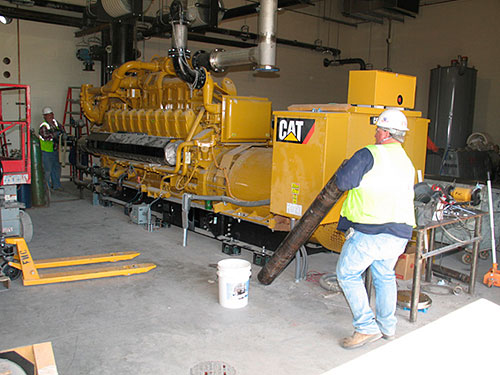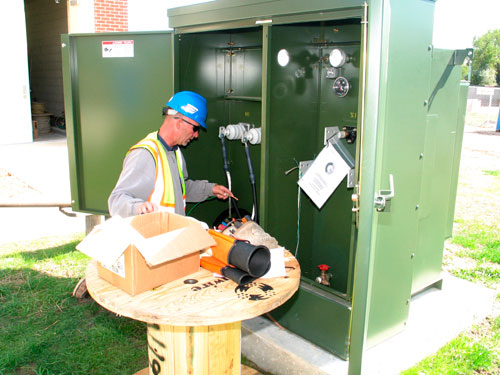Power from the people Trades build system that turns landfill methane into electricity
Date Posted: October 1 2010
MIDLAND – The city is sponsoring construction that will turn brown energy into greenbacks, saving taxpayers thousands of dollars in energy costs.
Under construction on the grounds of the city’s wastewater treatment plant is an energy recovery plant that will convert formerly wasted methane gas created by a city landfill into fuel that can be processed and burned to create electricity. Waste heat from generators powered by the methane will also be recovered and used to lower heating bills in city facilities.
The Midland Landfill Gas-To-Energy Project is expected to initially capture a consistent gas volume of 600-700 cubic-feet per-minute, which is capable of producing 3.2 megawatts of power – enough to power operations at the city’s wastewater treatment plant, as well as the city’s nearby water plant and (partially) a city-owned ice arena.
“I like the job, it’s interesting,” said IBEW Local 948 foreman Scott Kulhanek, who is employed by Newkirk Electric to wire electricity from the methane-fueled generators. “It’s great they’re finding a use for all that methane instead of just burning it off.”
Currently the City of Midland’s landfill gas is an untapped resource. According to a presentation made to the Midland City Council by Utilities Director Noel Bush, under the new plan the landfill gas will be collected through a series of wells and header pipes. Vacuums will balance the pressure of the incoming gas. But it is, of course, a dirty gas – only 50 percent of the fumes are actual methane, and it’s contaminated by moisture. The moisture and other contaminants need to be removed before it can be pumped about three miles to the grounds of the city’s Wastewater Treatment Plant, where the Gas-To-Energy Building is under construction.
Inside that building, the methane will fire a pair of V-20, 2,200 horsepower Caterpillar 3520s engines, which are specifically designed to burn methane and create the electricity. Unless the City of Midland wants to create a utility – and it doesn’t – the city must use the power that’s generated for it’s own purposes, so it’s powering the nearby wastewater treatment plant, water plant and an ice arena.
Furthermore, sludge from the city’s wastewater treatment plant will be scientifically refined before it’s placed in the city’s landfill, to improve gas generation and more quickly decompose the waste – with an added plus of reducing the potential for groundwater contamination.
“If you have a powerhouse you have to buy the gas and buy the equipment. In this case we have the gas, we have to destroy it anyway, and this is a more efficient method of destruction, and at the same time gives us energy,” Bush told the City Council. “This is not cutting edge technology, this is not new technology. The only thing different is the City of Midland happens to own the wastewater treatment plant, own the water plant and own the landfill. We’re fairly unique in that City of Midland owns its own landfill.”
Only a handful of cities in Michigan have embarked on similar projects, he said, because few own their own landfill.
Optimizing the 329-acre landfill for methane production is a science unto itself. Midland has closed and covered a number of bays in its landfill, but wells will be sunk to claim methane from them. Where new waste is being placed, the city will also put yard waste and optimized sludge into the mix, which will maximize the creation of methane. Regulating the presence of water, nutrients, temperature and ph all play a role in creating a good methane-creating mix in the landfill.
Initially, the city is projecting a 30 percent reduction in the cost of electricity and 50 percent reduction in natural gas use at the city’s water and wastewater treatment plants when power generation reaches full production. However, Bush said those are conservative numbers – they’re hoping for 50 percent electrical savings and 90 percent natural gas savings over the 50-year anticipated life of the project.
The project will also include the installation of a 10 million BTU/hour waste heat recovery system at the electric generating facility that will heat the Wastewater Treatment Plant’s digesters and provide heat to the WWTP’s buildings.
Bush said this project is simply building a power plant on a very small scale. The $12.3 million project “only makes sense if it pays for itself,” he said, without specifying the number of years for the payoff. He did say that the waste heat recovery system alone would reduce natural gas bills at the wastewater and water treatment plants by $150,000 per year.
According the Environmental Protection Agency, as of 2008 only 400 municipal waste landfills had a system in place to turn landfill gas into energy.

HEFTING A SIX-INCH steel pipe in front of one of the two V-20, 2,200 h.p. engines at the Midland Landfill Gas-To-Energy Project is Pate Holliday of Plumbers and Pipe Fitters Local 333. At left is Bill Hard of Plumbers and Steamfitters Local 85. They’re working for Franklin-Holwerda.

SETTING UP A 4160 KV transformer serving the Midland Gas-To-Energy Building is Scott Kulhanek of IBEW Local 948, working for Newkirk Electric.
